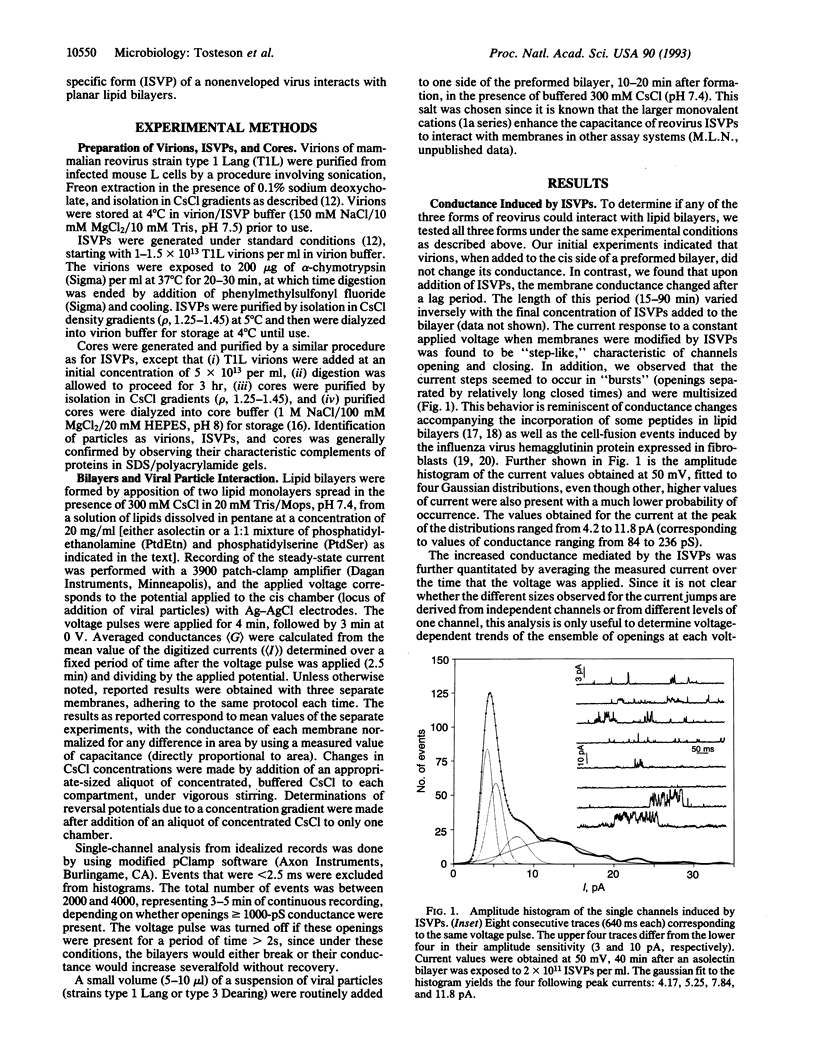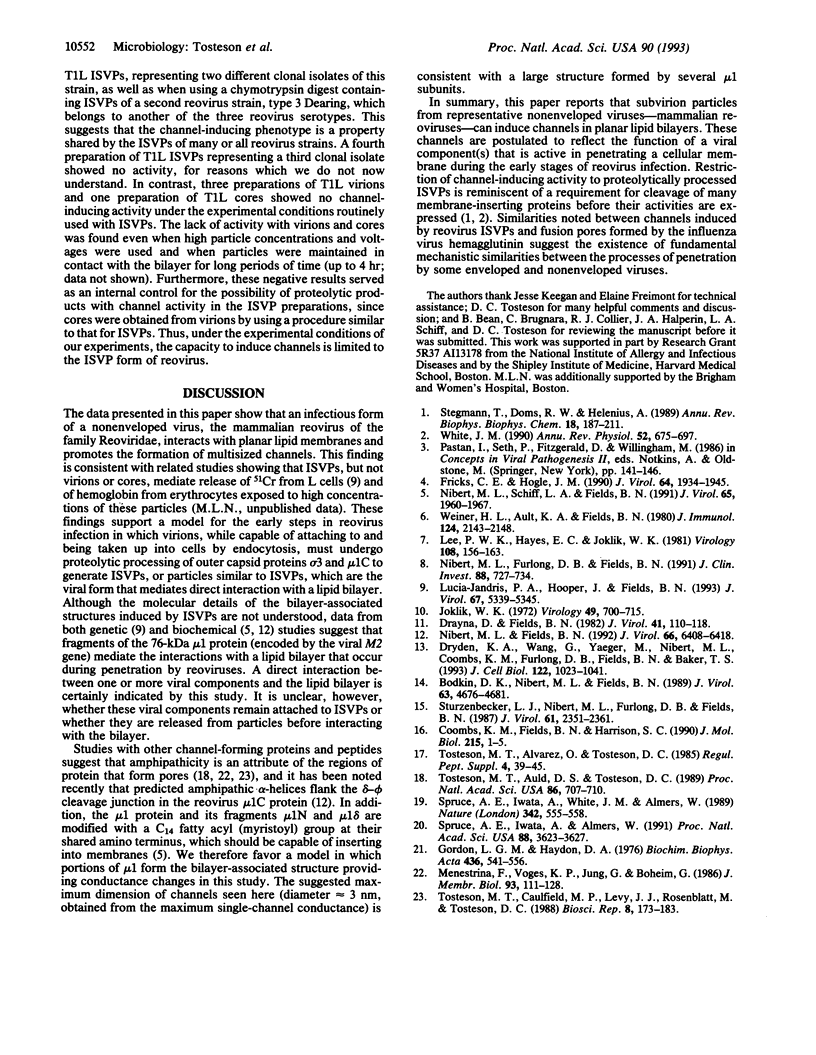Abstract
Mechanisms by which nonenveloped viruses penetrate cell membranes as an early step in infection are not well understood. Current ideas about the mode for cytosolic penetration by nonenveloped viruses include (i) formation of a membrane-spanning pore through which viral components enter the cell and (ii) local breakdown of the cellular membrane to provide direct access of infecting virus to the cell's interior. Here we report that of the three viral particles of nonenveloped mammalian reoviruses: virions, infectious subvirion particles, and cores (the last two forms generated from intact reovirus virions by proteolysis), only the infectious subvirion particles induced the formation of anion-selective, multisized channels in planar lipid bilayers under the experimental conditions used in this study. The value for the smallest size conductance varied depending on the lipid composition of the bilayer between 90 pS (Asolectin) and 300 pS (phosphatidylethanolamine:phosphatidylserine) and was found to be voltage independent. These findings are consistent with a proposal that the proteolytically activated infectious subviral particles mediate the interaction between virus and the lipid bilayer of a cell membrane during penetration. In addition, the findings indicate that the "penetration proteins" of some enveloped and nonenveloped viruses share similarities in the way they interact with bilayers.
Full text
PDF



Selected References
These references are in PubMed. This may not be the complete list of references from this article.
- Bodkin D. K., Nibert M. L., Fields B. N. Proteolytic digestion of reovirus in the intestinal lumens of neonatal mice. J Virol. 1989 Nov;63(11):4676–4681. doi: 10.1128/jvi.63.11.4676-4681.1989. [DOI] [PMC free article] [PubMed] [Google Scholar]
- Drayna D., Fields B. N. Activation and characterization of the reovirus transcriptase: genetic analysis. J Virol. 1982 Jan;41(1):110–118. doi: 10.1128/jvi.41.1.110-118.1982. [DOI] [PMC free article] [PubMed] [Google Scholar]
- Dryden K. A., Wang G., Yeager M., Nibert M. L., Coombs K. M., Furlong D. B., Fields B. N., Baker T. S. Early steps in reovirus infection are associated with dramatic changes in supramolecular structure and protein conformation: analysis of virions and subviral particles by cryoelectron microscopy and image reconstruction. J Cell Biol. 1993 Sep;122(5):1023–1041. doi: 10.1083/jcb.122.5.1023. [DOI] [PMC free article] [PubMed] [Google Scholar]
- Gordon L. G., Haydon D. A. Kinetics and stability of alamethicin conducting channels in lipid bilayers. Biochim Biophys Acta. 1976 Jul 1;436(3):541–556. doi: 10.1016/0005-2736(76)90439-9. [DOI] [PubMed] [Google Scholar]
- Lee P. W., Hayes E. C., Joklik W. K. Protein sigma 1 is the reovirus cell attachment protein. Virology. 1981 Jan 15;108(1):156–163. doi: 10.1016/0042-6822(81)90535-3. [DOI] [PubMed] [Google Scholar]
- Lucia-Jandris P., Hooper J. W., Fields B. N. Reovirus M2 gene is associated with chromium release from mouse L cells. J Virol. 1993 Sep;67(9):5339–5345. doi: 10.1128/jvi.67.9.5339-5345.1993. [DOI] [PMC free article] [PubMed] [Google Scholar]
- Menestrina G., Voges K. P., Jung G., Boheim G. Voltage-dependent channel formation by rods of helical polypeptides. J Membr Biol. 1986;93(2):111–132. doi: 10.1007/BF01870804. [DOI] [PubMed] [Google Scholar]
- Nibert M. L., Furlong D. B., Fields B. N. Mechanisms of viral pathogenesis. Distinct forms of reoviruses and their roles during replication in cells and host. J Clin Invest. 1991 Sep;88(3):727–734. doi: 10.1172/JCI115369. [DOI] [PMC free article] [PubMed] [Google Scholar]
- Nibert M. L., Schiff L. A., Fields B. N. Mammalian reoviruses contain a myristoylated structural protein. J Virol. 1991 Apr;65(4):1960–1967. doi: 10.1128/jvi.65.4.1960-1967.1991. [DOI] [PMC free article] [PubMed] [Google Scholar]
- Spruce A. E., Iwata A., Almers W. The first milliseconds of the pore formed by a fusogenic viral envelope protein during membrane fusion. Proc Natl Acad Sci U S A. 1991 May 1;88(9):3623–3627. doi: 10.1073/pnas.88.9.3623. [DOI] [PMC free article] [PubMed] [Google Scholar]
- Spruce A. E., Iwata A., White J. M., Almers W. Patch clamp studies of single cell-fusion events mediated by a viral fusion protein. Nature. 1989 Nov 30;342(6249):555–558. doi: 10.1038/342555a0. [DOI] [PubMed] [Google Scholar]
- Stegmann T., Doms R. W., Helenius A. Protein-mediated membrane fusion. Annu Rev Biophys Biophys Chem. 1989;18:187–211. doi: 10.1146/annurev.bb.18.060189.001155. [DOI] [PubMed] [Google Scholar]
- Sturzenbecker L. J., Nibert M., Furlong D., Fields B. N. Intracellular digestion of reovirus particles requires a low pH and is an essential step in the viral infectious cycle. J Virol. 1987 Aug;61(8):2351–2361. doi: 10.1128/jvi.61.8.2351-2361.1987. [DOI] [PMC free article] [PubMed] [Google Scholar]
- Tosteson M. T., Alvarez O., Tosteson D. C. Peptides as promoters of ion-permeable channels. Regul Pept Suppl. 1985;4:39–45. doi: 10.1016/0167-0115(85)90216-2. [DOI] [PubMed] [Google Scholar]
- Tosteson M. T., Auld D. S., Tosteson D. C. Voltage-gated channels formed in lipid bilayers by a positively charged segment of the Na-channel polypeptide. Proc Natl Acad Sci U S A. 1989 Jan;86(2):707–710. doi: 10.1073/pnas.86.2.707. [DOI] [PMC free article] [PubMed] [Google Scholar]
- Tosteson M. T., Caulfield M. P., Levy J. J., Rosenblatt M., Tosteson D. C. The synthetic precursor specific region of pre-pro-parathyroid hormone forms ion channels in lipid bilayers. Biosci Rep. 1988 Apr;8(2):173–183. doi: 10.1007/BF01116462. [DOI] [PubMed] [Google Scholar]
- Weiner H. L., Ault K. A., Fields B. N. Interaction of reovirus with cell surface receptors. I. Murine and human lymphocytes have a receptor for the hemagglutinin of reovirus type 3. J Immunol. 1980 May;124(5):2143–2148. [PubMed] [Google Scholar]
- White J. M. Viral and cellular membrane fusion proteins. Annu Rev Physiol. 1990;52:675–697. doi: 10.1146/annurev.ph.52.030190.003331. [DOI] [PubMed] [Google Scholar]


